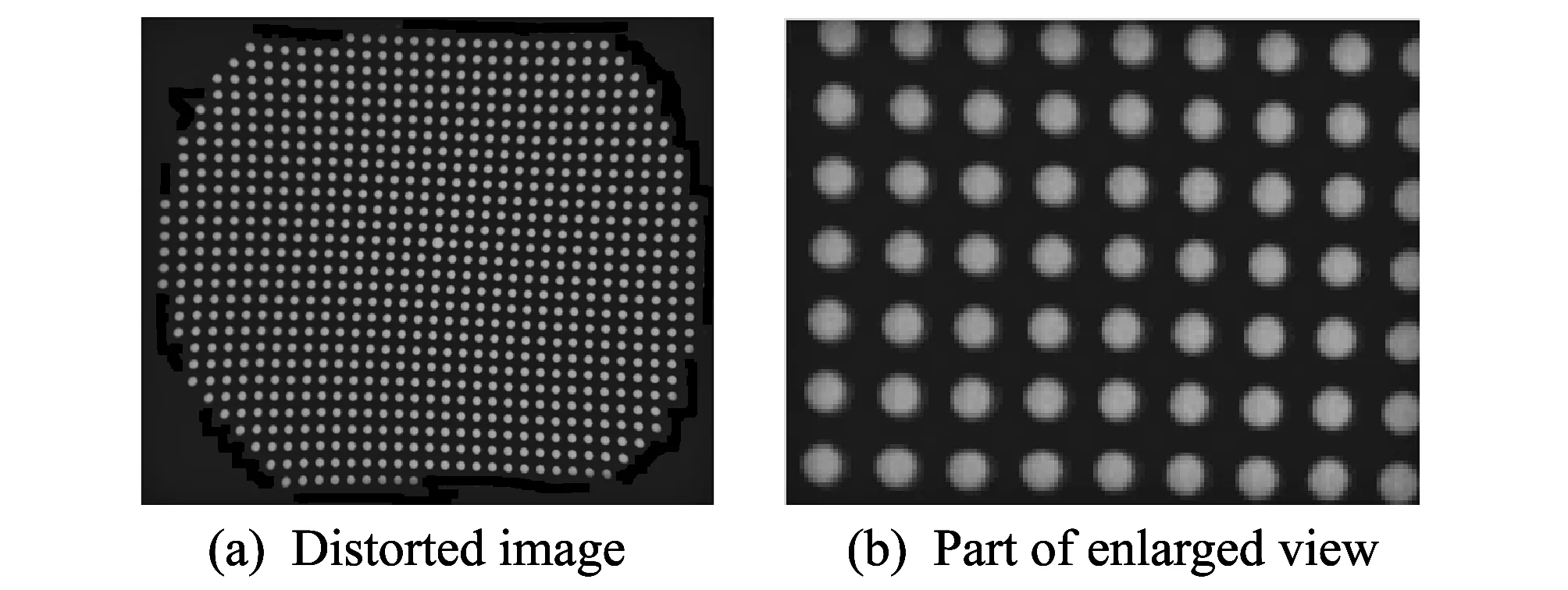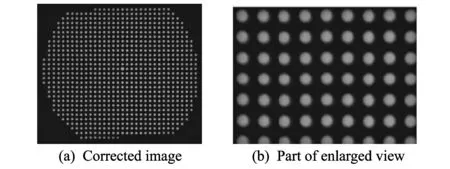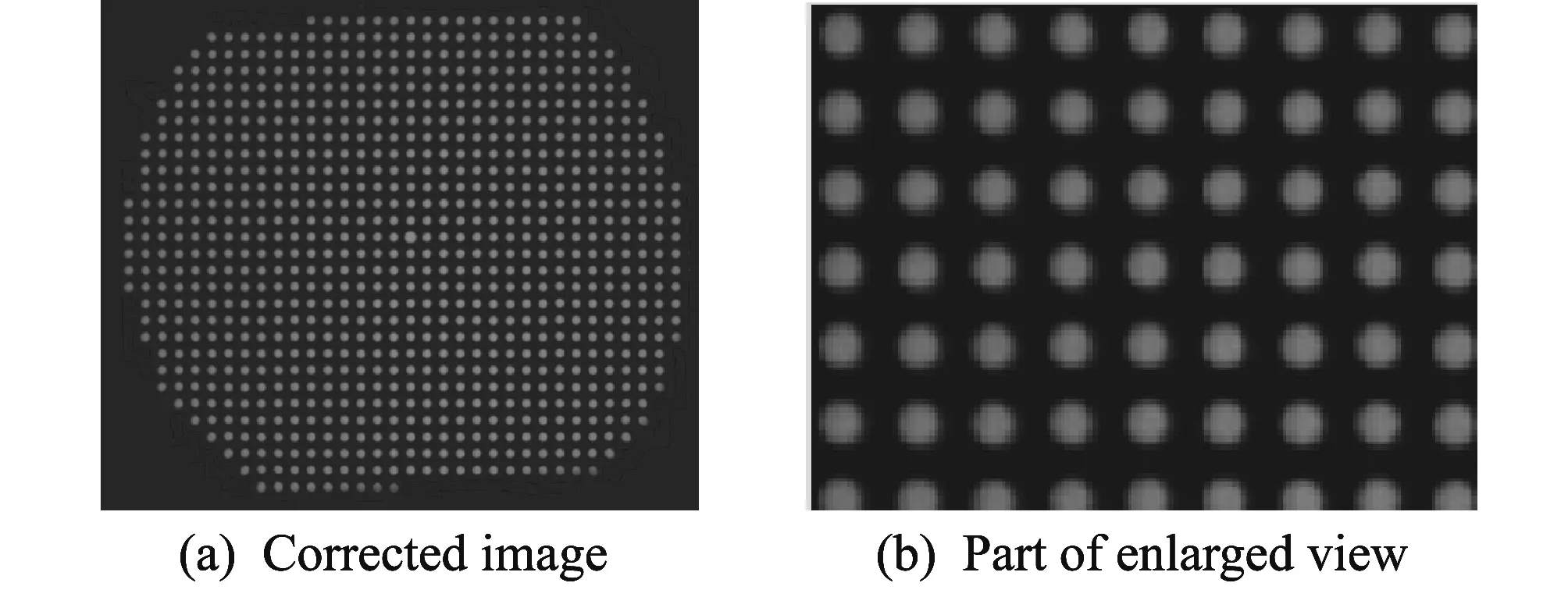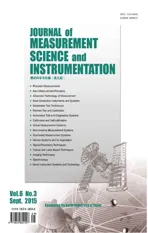X-ray image distortion correction based on SVR
2015-03-03YUANZehuiLIShizhong
YUAN Ze-hui, LI Shi-zhong
(College of Mechatronic Engineering, North University of China, Taiyuan 030051, China)
袁泽慧, 李世中
(中北大学 机电工程学院, 山西 太原 030051)
X-ray image distortion correction based on SVR
YUAN Ze-hui, LI Shi-zhong
(CollegeofMechatronicEngineering,NorthUniversityofChina,Taiyuan030051,China)
X-ray image has been widely used in many fields such as medical diagnosis, industrial inspection, and so on. Unfortunately, due to the physical characteristics of X-ray and imaging system, distortion of the projected image will happen, which restrict the application of X-ray image, especially in high accuracy fields. Distortion correction can be performed using algorithms that can be classified as global or local according to the method used, both having specific advantages and disadvantages. In this paper, a new global method based on support vector regression (SVR) machine for distortion correction is proposed. In order to test the presented method, a calibration phantom is specially designed for this purpose. A comparison of the proposed method with the traditional global distortion correction techniques is performed. The experimental results show that the proposed correction method performs better than the traditional global one.
X-ray image; distortion correction; support vector regression machine
X-ray technology has been widely used in a number of fields, especially industrial and medical fields[1]. In the last years, there has been an increasing interest in using projected images to generate three-dimensional (3D) tomographic reconstructions. However, because the the original projected images are distorted, the quality of the reconstructed images is deteriorated. Therefore, how to correct the distortions becomes necessary for using X-ray images.
Among various types of distortion, pincushion distortion and S-distortion are predominant[2]. The former is the most visually apparent due to photocathode curvature. The latter is introduced by the electron optics of image intensifier and interaction with external magnetic fields, mainly earth magnetic field.
Correction for spatial distortion in X-image is achieved by imaging a regular calibration grid, consisting of either transparent holes or small opaque objects, which represent the control points and are used to compute the correction coefficients. An interpolation function is to build the map between ideal and raw pixel locations of control points.
Several methods have been developed to correct the distortion in X-ray images. Normally these correction methods are classified into global methods[3-6]and local methods[7]. In global correction techniques, a single pair of equations in the form of a high-order polynomial (usually a 4th or 5th-order polynomial) are used to correct the image. The global methods are implemented easily and fast. However, for some local distortions that may appear in the acquired image, they can not be corrected and require an excessive calibration of the system. For overcoming the existing problems of global methods, local method is developed. In local correction methods, the raw image is divided into many small areas (usually rectangular or triangular) firstly, and the distortion of each local area is corrected respectively. Since different correction equations are used for each local area, for the neighboring regions, the discontinuities are introduced, which represent the major problem in local methods.
Both global methods and local methods have their advantages and disadvantages. In this paper, a new global method based on support vector machine (SVM) is proposed, which is based on the strong regression ability of SVM.
1 Material and method
The correction for two-dimensional X-ray image distortion is usually achieved by imaging a regular grid phantom, consisting of either transparent holes or small opaque objects, which are used as control points. In this paper, a thin plate with a series of small holes and a large hole, placed in a regular pattern, is specially designed for the correction work. The small holes are inside a circle with a diameter of 3.1 mm, while the large hole, displaced at the centre of the thin plate and used as the original control point, has a diameter of 4.2 mm. The step between holes (the distance between their centers) is 6 mm. The image of the designed thin plate is shown in Fig.1.

Fig.1 Thin plate attached to the face of XRLL
In this paper, a new global method based on support vector regression (SVR) for correcting distortion is proposed. As other correction methods, the presented approach mainly involves: (1) automatic control points detection (2) correction modeling (3) application of the correction model to individual images, i.e. image correction. In the following, a detailed description of these steps is given.
1.1 Automatic grid detection
As described in above, the centers of holes are used as control points for distortion correction. To detect the centers of holes precisely, image prepossessing and segmentation are carried out. After that, the segmented disjointed pixels are grouped into hole-clusters. Following the clustering operation, for each hole-cluster, mass center approach is used calculate its center coordinates. Next, all the center coordinates are put into a matrix according to their ideal grid orders.
Distortion correction is to build a mapping model, i.e. a correction model, between the control point coordinates (the holes’ mass centers in this case) of the raw distorted image and the ideal one. After the procedure described previously, the distorted control point coordinates are detected automatically. However, for the ideal image, it is not easy to be obtained since the ideal X-ray image is unknown. In our case, a large hole at the center of the thin plate is specially designed, which is based on the characteristics of pincushion distortion and S-distortion that the distortion in the central part is small. To obtain other small holes’ ideal mass centers, the step between two neighboring centers is calculated by averaging all the steps of each neighboring couple of holes. Then according to the mass center of the large hole and the calculated step, the other small holes’ ideal mass centers are obtained.
1.2 Support vector regression machine theory
The support vector machines (SVMs) were proposed by Vapnik[8]in 1998. In the last years, it has been widely used for classification[9-10]and regression[11-12]. When SVM is applied to regression by introducing an alternative loss function, it is termed as SVR.
The basic idea of SVR is that the data vectorxfrom the inputXis mapped into a high-dimensional feature spaceFby a nonlinear mappingΦ(x),andthenlinearregressionisconductedinFspace.
Given a set of training data {(x1,y1),(x2,y2),…,(xn,yn)}∈X×R,thegoalofSVRistofindafunctionf(x)thatisnotmorethanεfromthetargetsyiforallthetrainingdata,andatthesametime,itisasflataspossible.Thelinearfunctionf(x)isformulatedas
(1)
FlatnessinEq.(1)meansthatoneseekssmallw. One way to ensure this is to minimize the Euclidean norm, i.e. ‖w‖2.Thenthisproblemcanbeformulatedasaconvexoptimizationproblembyrequiring
(2)

(3)
TheconstantC>0determinesthetrade-offoferrormarginbetweentheflatnessoff(x)andtheamountofdeviationinexcessofεthatistolerated.ToenabletheSVRtopredictanonlinearsituation,SVRmapstheinputdataintothefeaturespacebyΦ(X),whichisdenotedby


ThedecisionfunctioncanbecomputedbytheinnerproductsofΦ(x)TΦ(xi)withoutexplicitlymappingxinto a higher dimension, which saves considerable computation efforts.Φ(x)TΦ(xi)iscalledkernelfunctionK(x,xi)≡Φ(x)TΦ(xi).ChoosingdifferenttypesofkernelfunctionscangeneratedifferentSVRmodels.
2 Experiment results
2.1 Determination of SVR parameters
The generalization ability of SVR relies entirely on a group of parameters. In this paper, a mixture kernel of polynomial kernel and radial basis kernel is used. And for the loss function,ε-insensitive loss function is selected. Therefore, it is needed to determine the following parameters: regularization factorC,εof theε-insensitive loss function,σof Gaussian radial basis function, the orderdof polynomial order Kernel, and the mixture coefficientλ.
The final SVR coefficients were selected as

2.2 Experiment results
In this section the presented SVR model is tested to correct the raw distorted X-ray image. Meanwhile it is compared with the most commonly used polynomial model, and the polynomial model’s order is set to 4. The raw distorted image is shown in Fig.2. And the corrected images are presented in Fig.3 and Fig.4, respectively.

Fig.2 Raw distorted X-ray image

Fig.3 Corrected image using polynomial model

Fig.4 Corrected image using SVR model
In order to compare the two controllers performance quantitatively, the following measures are taken.

Fig.5showstheresidualdisplacementofthecorrectedimagesusingpolynomialandSVRmodel,respectively.ItiseasytonoticethatforFig.5(b),alltheerrorsarelessthan0.6pixels.HoweverinFig.5(a),althoughmostoftheerrorsarelessthan0.6pixels,therearestillafewnumberofcontrolpoints’residualdisplacementswhichareevenlargerthan2.5pixels,whichcorrespondstothelocaldistortionsthattheglobalpolynomialmodelcannotcorrect.

Fig.5 Residual displacement histograms of corrected images
2) For the corrected image, two control points in a row are formed into a vector. Since the control points, i.e. the holes are displaced in a grid pattern, the angel between the formed vector with the horizontal vector is calculated. It is easy to know that the ideal angle is equal to 0. To explain conveniently, the vector formed by the control points in a row is named row-center-vector.
The histograms of calculated angles of images corrected by global pronominal model and SVR model are shown in Fig.6(a) and (b), respectively.
It is easy to observe that, compared with Fig.6(a), there are few angles larger than 1.2 degree in Fig.6(b), which means that by using SVR model, the distortion near the bounding is corrected mostly. Meanwhile, it is can be known that there are 462 angles which are less than 0.4°, which is much larger than 375 in Fig.6(a).

Fig.6 Histogram of angles between row-center-vector and horizontal vector
It can be concluded from the comparison results that the display of control points in image corrected by SVR model is much close to the ideal grid, i.e. for correcting the distorted images, the SVR model performs better than global polynomial model.
3 Conclusion
In this research, a correction algorithm based on SVR model has been proposed to correct the distortion of the acquired images by X-ray projector. Based on the extracted centers, the correcting SVR model is built and then applied to the raw distorted images. The experiments show that much of the distortion in raw image is found to be effectively corrected. And the developed SVR model performs better than the 4th order polynomial model in two aspects.
[1] Lee K, Lee K M, Park M S, et al. Measurements of surgeons’ exposure to ionizing radiation does during intra-operative use of C-arm fluoroscopy. Spine, 2012, 37(14): 1240-1244.
[2] WANG Xiao-hui, NING Ruo-la. Accurate and efficient image intensifier distortion correction algorithm and its application in volume tomographic angiography. In: Proceedings of Medical Imaging 1997: Physics of Medical Imaging, Newport Beach, CA, USA ,1997, 3032(427): 427-440.
[3] YAN Shi-ju, WANG Cheng-tao, YE Ming. A method based on moving least squares for XRII image distortion correction. Medical Physics, 2007, 34(11): 4194-4206.
[4] Holdsworth D W, Pollmann S I, Nicolov H N, et al. Correction of XRII geometric distortion using a liquid-filled grid and image subtraction. Medical Physics, 2005, 32(1): 55-64.
[5] YAN Shi-ju, QIAN Li-wei. XRII image distortion correction for C-arm-based surgical navigation system. Journal of Biomedical Engineering, 2010, 27(3): 548-551.
[6] LI Yuan-jin, LUO Li-min, ZHANG Peng-cheng, et al. Distortion correction of XRII image based on calibration grid characteristic and biharmonic interpolation. Journal of Southeast University (Natural Science Edition), 2011, 41(6): 1213-1218.
[7] Cerveria P, Forlani C, Borghese N A, et al. Distortion correction for x-ray image intensifier: local unwarping polynomials and RBF neural networks. Medical Physics, 2002, 29(8): 1759-1771.
[8] Vapnik V N. The nature of statistical learning theory. New York: Springer-Verlag, 1998.
[9] Deyong D, Bhowmik S, Magnago F. An effective power quality classifier using wavelet transform and support vector machine. Expert Systems with Application, 2015, 45(15/16): 6075-6081.
[10] CAO Jian-fang, CHEN Jun-jie, CHEN Li-chao. An improved image classification method basd on multi features using fuzzy support vector machine. BioTechnology, 2014, 10(11): 5543-5542.
[11] Avila F, Mora M, Oyarce M. A method to construct fruit maturity color scales based on support machines for regression: application to olives and grape seeds. Journal of Engineering, 2014, 162: 9-17.
[12] Waleed D, Sohel R, Habshah M. Non-sparse epsilon-insensitive support vector regression for outlier detection. Journal of Applied Statistics, 2015, 42(8): 1723-1739.
基于支持向量回归机的X射线图像畸变校正研究
X射线图像已经被广泛的应用于各个领域, 如医学诊断, 工业检测等。 然而, 由于x射线及其成像系统的物理特性, 得到的X图像存在严重畸变, 这极大限制了X射线在一些高精度场合的应用, 因此需对原始的x射线图像进行校正。 所谓图像畸变校正, 就是设法建立畸变图像特征点坐标与理想图像特征点坐标之间的映射模型, 即校正模型, 将畸变的点恢复到原来的位置。 目前常用的畸变校正方法主要分为两类: 全局校正法和局部校正法, 这两种方法都有各自的优缺点。 本文提出了利用支持向量回归机建立校正模型的一种全局校正方法, 并将其与全局多项式模型做比较, 通过比较两种模型的校正图像中特征点分布与理想分布的符合度, 检验所提出算法的效果。 实验结果表明, 提出的算法效果明显好于传统的多项式方法。
X-射线图像; 畸变校正; 支持向量回归机
YUAN Ze-hui, LI Shi-zhong. X-ray image distortion correction based on SVR. Journal of Measurement Science and Instrumentation, 2015, 6(3): 302-306. [
袁泽慧, 李世中
(中北大学 机电工程学院, 山西 太原 030051)
10.3969/j.issn.1674-8042.2015.03.018]
Received date: 2015-05-14 Foundation items: National Natural Science Foundation of China (No.61305118)
YUAN Ze-hui (yuanzehui1985@126.com)
1674-8042(2015)03-0302-05 doi: 10.3969/j.issn.1674-8042.2015.03.018
CLD number: TP391.41 Document code: A
猜你喜欢
杂志排行
Journal of Measurement Science and Instrumentation的其它文章
- Numerical simulation of two-phase flow field in underwater sealing device based on dynamic mesh
- Ballistic impact simulation of Kevlar-129 fiber reinforced composite material
- Design of IRIG-B(AC) encoder based on FPGA
- Application of adaptive Kalman filter in rocket impact point estimation
- Analysis of movement laws of fragment and shock wave from a blast fragmentation warhead
- Simulation of small-aperture deep hole drilling based on ABAQUS
